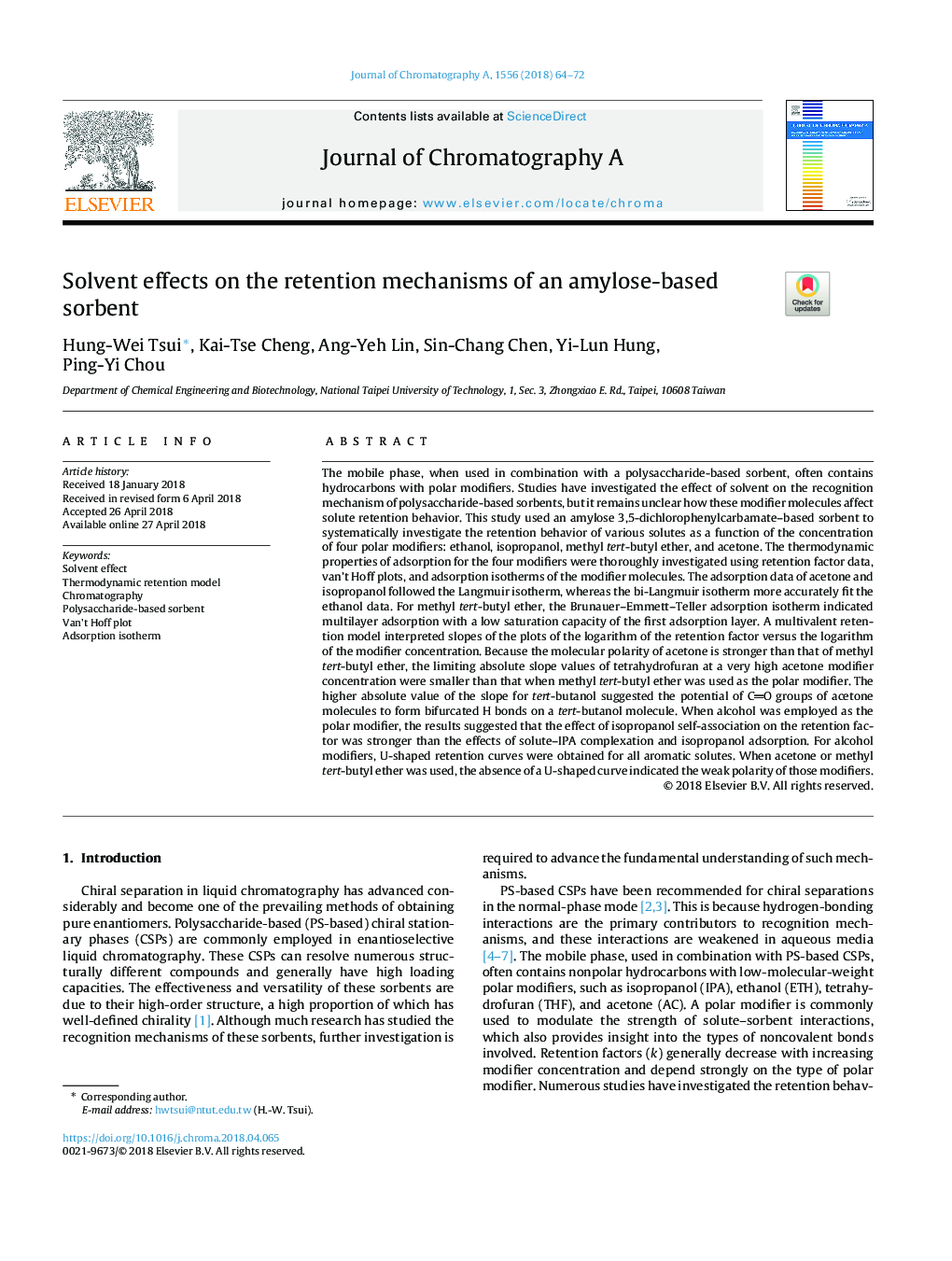| کد مقاله | کد نشریه | سال انتشار | مقاله انگلیسی | نسخه تمام متن |
|---|---|---|---|---|
| 7608003 | 1493370 | 2018 | 9 صفحه PDF | دانلود رایگان |
عنوان انگلیسی مقاله ISI
Solvent effects on the retention mechanisms of an amylose-based sorbent
دانلود مقاله + سفارش ترجمه
دانلود مقاله ISI انگلیسی
رایگان برای ایرانیان
کلمات کلیدی
موضوعات مرتبط
مهندسی و علوم پایه
شیمی
شیمی آنالیزی یا شیمی تجزیه
پیش نمایش صفحه اول مقاله

چکیده انگلیسی
The mobile phase, when used in combination with a polysaccharide-based sorbent, often contains hydrocarbons with polar modifiers. Studies have investigated the effect of solvent on the recognition mechanism of polysaccharide-based sorbents, but it remains unclear how these modifier molecules affect solute retention behavior. This study used an amylose 3,5-dichlorophenylcarbamate-based sorbent to systematically investigate the retention behavior of various solutes as a function of the concentration of four polar modifiers: ethanol, isopropanol, methyl tert-butyl ether, and acetone. The thermodynamic properties of adsorption for the four modifiers were thoroughly investigated using retention factor data, van't Hoff plots, and adsorption isotherms of the modifier molecules. The adsorption data of acetone and isopropanol followed the Langmuir isotherm, whereas the bi-Langmuir isotherm more accurately fit the ethanol data. For methyl tert-butyl ether, the Brunauer-Emmett-Teller adsorption isotherm indicated multilayer adsorption with a low saturation capacity of the first adsorption layer. A multivalent retention model interpreted slopes of the plots of the logarithm of the retention factor versus the logarithm of the modifier concentration. Because the molecular polarity of acetone is stronger than that of methyl tert-butyl ether, the limiting absolute slope values of tetrahydrofuran at a very high acetone modifier concentration were smaller than that when methyl tert-butyl ether was used as the polar modifier. The higher absolute value of the slope for tert-butanol suggested the potential of CO groups of acetone molecules to form bifurcated H bonds on a tert-butanol molecule. When alcohol was employed as the polar modifier, the results suggested that the effect of isopropanol self-association on the retention factor was stronger than the effects of solute-IPA complexation and isopropanol adsorption. For alcohol modifiers, U-shaped retention curves were obtained for all aromatic solutes. When acetone or methyl tert-butyl ether was used, the absence of a U-shaped curve indicated the weak polarity of those modifiers.
ناشر
Database: Elsevier - ScienceDirect (ساینس دایرکت)
Journal: Journal of Chromatography A - Volume 1556, 29 June 2018, Pages 64-72
Journal: Journal of Chromatography A - Volume 1556, 29 June 2018, Pages 64-72
نویسندگان
Hung-Wei Tsui, Kai-Tse Cheng, Ang-Yeh Lin, Sin-Chang Chen, Yi-Lun Hung, Ping-Yi Chou,